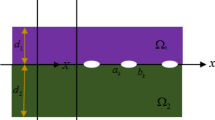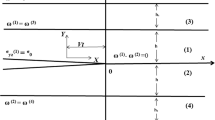Abstract
An interface crack between dissimilar elastic thin-films with surface effect has been investigated. By using integral transform technique the mixed boundary value problem of an interface crack is reduced to singular integral equations, which can be further reduced to a Riemann–Hilbert problem with analytical solution. The crack-tip singularities of the interface crack have been studied for possible combination of the dissimilar isotropic elastic materials with surface effect, and it is shown that there can be either oscillatory or non-oscillatory singularity for the interface crack. Analytical solution of the normal and shear stresses on the bonded interface is obtained, the relative crack opening displacement (COD) and relative crack sliding displacement (CSD) were given, and energy release rates (ERRs) for the interface crack are obtained for both oscillatory and non-oscillatory singularity cases. The oscillatory and non-oscillatory singularity parameters for interface cracks between dissimilar isotropic elastic materials with surface effect have been obtained.









Similar content being viewed by others
References
Hutchinson, J.W., Suo, Z.: In Advances in Applied Mechanics (eds J.W. Hutchinson and T.Y. Wu), 29, 63-191. Academic Press, New York. (1991)
Williams, M.L.: The stresses around a fault or crack in dissimilar media. B. Seismolo. Soc. Am. 49, 199–204 (1959)
England, A.H.: A crack between dissimilar media. J. Appl. Mech. 30, 400–402 (1965)
Enrique, G., Vladislav, M., Federico, P.: On the estimation of the first interpenetration point in the open model of interface cracks. Int. J. Fract. 143, 287–290 (2007)
Zhao, J.-M., Wang, H.-L., Liu, B.: Two objective and independent fracture parameters for interface cracks. J. Appl. Mech. 84, 041006-1–9 (2017)
Hills, D.A., Barber, J.R.: Interface cracks. Int. J. Mech. Sci. 35, 27–37 (1993)
Comninou, M.: The interface crack. J. Appl. Mech. 44, 631–636 (1977)
Clements, D.L.: A crack between dissimilar anisotropic media. Int. J. Eng. Sci. 9, 257–265 (1971)
Suo, Z.: Singularities, interfaces and cracks in dissimilar anisotropic media. Proc. Roy. Soc. Lond. A 447, 331–358 (1990)
Erdogan, F., Wu, B.H.: Interface crack problems in layered orthotropic materials. J. Mech. Phys. Solids 41, 889–917 (1993)
Ru, C.Q.: A hybrid complex-variable solution for piezoelectric/isotropic elastic interfacial cracks. Int. J. Fract. 152, 169–178 (2008)
Gao, C.-F., Mai, Y.-W.: Singularities of an interface crack in electrostrictive materials. Int. J. Solids Struct. 48, 1395–1401 (2011)
Kuo, C.M., Barnett, D.M.: Stress singularities of interfacial cracks in bonded piezoelectric half-spaces. In: Wu, J.J., Ting, T.C.T., Barnett, D.M. (eds.) Modern Theory of Anisotropic Elasticity and Applications, pp. 33-50. SIAM Proceedings Series, Philadelphia (1991)
Suo, Z., Kuo, C.M., Narnett, D.M., Willis, J.R.: Fracture mechanics for piezoelectric ceramics. J. Mech. Phys. Solids 40, 739–765 (1992)
Eda, G., Fanchini, G., Chhowalla, M.: Large-area ultrathin films of reduced grapheme oxide as a transparent and flexible electronic material. Nat. Nanotechnol. 3, 270–274 (2008)
He, L.H., Lim, C.W., Wu, B.S.: A continuum model for size-dependent deformation of elastic films of nano-scale thickness. Int. J. Solids Struct. 41, 847–857 (2004)
Altenbach, H., Eremeyev, V.A.: On the shell theory on the nanoscale with surface stresses. Int. J. Eng. Sci. 49, 1294–1301 (2011)
Zhang, T., Li, X., Gao, H.: Fracture of grapheme: A review. Int. J. Fract. 196, 1–31 (2015)
Wang, G.F., Feng, X.Q., Wang, T.J., Gao, W.: Surface effects on the near-tip stresses for mode-I and mode-III cracks. J. Appl. Mech. 75, 148–155 (2008)
Walton, J.R.: A note on fracture models incorporating surface elasticity. J. Elasticity 109, 95–102 (2012)
Kim, C., Ru, C.Q., Schiavone, P.: A clarification of the role of crack-tip conditions in linear elasticity with surface effects. Math. Mech. Solids 18, 59–66 (2013)
Wang, X., Fan, H.: Interaction between a nanocrack with surface elasticity and a screw dislocation. Math. Mech. Solids 22, 131–143 (2017)
Gorbushin, N., Eremeyev, V.A., Mishuris, G.: On Stress singularity near the tip of a crack with surface stresses. Int. J. Eng. Sci. 146, 103183 (2020)
Nan, H., Wang, B.: Effect of residual surface stress on the fracture of nanoscale materials. Mech. Res. Commun. 44, 30–34 (2012)
Wang, X., Schiavone, P.: A mode-III crack with variable surface effects. J. Theo. Appl. Mech. 54, 1319–1327 (2016)
Li, X.-F.: Effect of surface elasticity on stress intensity factors near mode-III crack tips. J. Mech. Mater. Struct. 14, 43–60 (2019)
Hu, Z.-L., Lee, K.Y., Li, X.-F.: Crack in an elastic thin-film with surface effect. Int. J. Eng. Sci. 123, 158–173 (2018)
Piccolroaz, A., Gorbushin, N., Mishuris, G., Nieves, M.J.: Dynamic phenomena and crack propagation in dissimilar elastic lattices. Int. J. Eng. Sci. 149, 103208 (2020)
Lurie, A.I., Belyaev, A.: Theory of Elasticity. Springer, Bergin, Heidelberg (2005)
Gurtin, M.E., Murdoch, A.I.: A continuum theory of elastic material surfaces. Arch. Ration. Mech. Anal. 57, 291–323 (1975)
Li, X.-F., Tang, G.-J., Shen, Z.-B., Lee, K.-Y.: Interface crack embedded in a bi-material plane under shear and compression. Mech. Mater. 85, 80–93 (2015)
Parton, V.Z.: Fracture mechanics of piezoelectric materials. Acta Astronaut. 3, 671–683 (1976)
Liu, M., Hsia, K.J.: Interfacial cracks between piezoelectric and elastic materials under in-plane electric loading. J. Mech. Phys. Solids 51, 921–944 (2003)
Hu, K.Q., Chen, Z.T., Zhong, Z.: Interface crack between magnetoelectroelastic and orthotropic half-spaces under in-plane loading. Theo. Appl. Fract. Mech. 96, 285–295 (2018)
Muskhelishvili, N.I.: Some Basic Problems of the Mathematical Theory of Elasticity. Noordhoff, Groningen (1963)
Dundurs, J.W.: Edge-bonded dissimilar orthotropic elastic wedges under normal and shear loading. J. Appl. Mech. 36, 650–652 (1969)
Rice, J.R.: Elastic fracture mechanics concepts for interfacial cracks. J. Appl. Mech. 55, 98–103 (1988)
Shenoy, V.B.: Atomistic calculations of elastic properties of metallic FCC crystal surfaces. Phys. Rev. B 71, 094104 (2005)
Choi, J., Cho, M., Kim, W.: Multiscale analysis of nanoscale thin film considering surface effects: Thermomechancial properties. J. Mech. Mater. Struct. 5, 161–183 (2010)
Acknowledgements
This work is supported by the National Natural Science Foundation of China (11872203) and for Creative Research Groups (51921003). The first author wishes to thank a start-up grant (YAH20074) from the Nan**g University of Aeronautics and Astronautics. Constructive comments from the reviewer are greatly appreciated.
Author information
Authors and Affiliations
Corresponding author
Additional information
Publisher's Note
Springer Nature remains neutral with regard to jurisdictional claims in published maps and institutional affiliations.
Appendix A
Appendix A
We consider dissimilar thin films of thickness h with an interface crack, see Fig.1, plane deformation is focused, and the displacement component along the thickness direction is neglected. The surface displacement components are taken as the bulk displacements at the same locations at the surface of the material.
If the body forces are neglected and the static problem is considered, the application of the principle of virtual work according to the bulk and surface stresses leads to
where \(\delta \) denotes the variation of a function, S is the area of the elastic plate and \(\partial S\) is the boundary of S, \(n_{\alpha } \) (\(\alpha =1,2)\) is the unit outer normal vector to the boundary \(\partial S\), and \(f_{\alpha } \) are the density of surface forces independent of the thickness. It is noted that the second term and the third term on the left-hand side of Eq. (A.1) demonstrate the contribution of the surface forces and surface residual stress along the boundary \(\partial S\), respectively.
Considering the following definition of strain with geometric nonlinearity terms
The substitution of Eq. (A.2) into Eq. (A.1) leads to
Applying the Green theorem to the first term of Eq. (A.3) leads to
and Eq. (A.3) can be rewritten as
By using the variational principle, the governing equation of elastic thin-films with surface elasticity effect can be obtained as
which is subjected to the following boundary condition
When the definition of the total incremental stress is introduced as in Eq. (5), the expansion of the governing equation (A.6) leads to Eqs. (3) and (4), and the boundary condition (A.7) leads to Eqs. (6) and (7).
The following identities for the integral of generalized functions have been used in the derivation of the singular integral equations (40)
where \(\delta ( )\) is the Dirac delta function.
In the derivation of the energy release rate (ERR) of the interface crack, the following integral identities have been used
It is noted that Eqs. (A.9) and (A.10) are mathematically the same considering the integral identity that is shown in Eq. (93).
Rights and permissions
About this article
Cite this article
Hu, K., Fu, J., Chen, Z. et al. Interface crack between dissimilar thin-films with surface effect. Z. Angew. Math. Phys. 73, 104 (2022). https://doi.org/10.1007/s00033-022-01710-2
Received:
Revised:
Accepted:
Published:
DOI: https://doi.org/10.1007/s00033-022-01710-2
Keywords
- Interface crack
- Dissimilar isotropic elastic materials
- Singular integral equations
- Riemann–Hilbert boundary problem
- Surface effect
- Energy release rates




